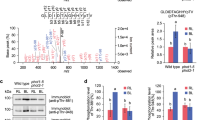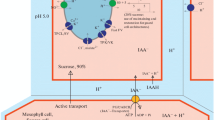Abstract
Leaflet movements of Samanea saman (Jacq.) Merr. depend in part upon circadian-rhythmic, light-regulated K+ fluxes across the plasma membranes of extensor and flexor cells in opposing regions of the leaf-moving organ, the pulvinus. We previously showed that blue light appears to close open K+ channels in flexor protoplasts during the dark period (subjective night) (Kim et al., 1992, Plant Physiol 99: 1532–1539). In contrast, transfer to darkness apparently closes open K+ channels in extensor protoplasts during the light period (subjective day) (Kim et al., 1993, Science 260: 960–962). We now report that both these channel-closing stimuli increase inositol 1,4,5-trisphosphate [Ins(1,4,5)P3] levels in the appropriate protoplasts. If extensor cells are given a pulse of red light followed by transfer to darkness, channels still apparently close (Kim et al. 1993) but changes in Ins(1,4,5)P3 levels are complex with an initial decrease under red light followed by accumulation. Neomycin, an inhibitor of polyphosphoinositide hydrolysis, inhibits both blue-light-induced Ins(1,4,5)P3 production and K+-channel closure in flexor protoplasts and both dark-induced Ins(1,4,5)P3 production and K+ channel closure in extensor protoplasts. The G-protein activator, mastoparan, mimics blue light and darkness in that it both increases Ins(1,4,5)P3 levels and closes K+ channels in the appropriate cell type at the appropriate time. These results indicate that phospholipase C-catalyzed hydrolysis of phosphoinositides, possibly activated by a G protein, is an early step in the signal-transduction pathway by which blue light and darkness close K+ channels in S. saman pulvinar cells.
Similar content being viewed by others
Abbreviations
- DiS-C3-(5):
-
3,3′-dipropylthiadicarbocyanine iodide
- ΔF:
-
measure change in Dis-C3-(5) fluorescence
- Fo :
-
initial Dis-C3-(5) fluorescence
- Ins(1,4,5)P3 :
-
inositol 1,4,5-trisphosphate
- PtdIns(4,5)P2 :
-
phosphatidylinositol 4,5-bisphosphate
- rbc:
-
red blood cell
References
Aridor M, Sagi-Eisenberg R (1990) Neomycin is a potent secretagogue of mast cells that directly activates a GTP-binding protein involved in exocytosis. J Cell Biol 111: 2885–2891
Assmann SM (1993) Signal transduction in guard cells. Annu Rev Cell Biol 9: 345–375
Balla T, Catt KJ (1994) Phosphoinositides and calcium signaling. New aspects and diverse functions in cell regulation. Trends Endocrinol Metab 5: 250–255
Berridge MJ (1993) Inositol trisphosphate and calcium signaling. Nature 361: 315–325
Birnbaumer L, Abramowitz J, Brown AM (1990) Receptoreffector coupling by G proteins. Biochim Biophys Acta 1031: 163–224
Busse R, Mülsch A (1994) Calcium-dependent nitric oxide synthesis in endothelial cytosol is mediated by calmodulin. FEBS Lett 265: 133–136
Coté GG, Crain RC (1994) Why do plants have phosphoinositides? BioEssays 16: 39–46
Coté GG, Morse MJ, Crain RC, Satter RL (1987) Isolation of soluble metabolites of the phosphatidylinositol cycle from Samanea saman. Plant Cell Rep 6: 352–355
Downes CP, Michell RH (1981) The polyphosphoinositide phosphodiesterase of erythrocyte membranes. Biochem J 198: 133–140
Downes CP, Mussat MC, Michell RH (1982) The inositol trisphosphate phosphomonoesterase of the human erythrocyte membrane. Biochem J 203: 169–177
Fairley-Grenot K, Assmann SM (1991) Evidence for G-protein regulation of inward K+ channel current in guard cells of fava bean. Plant Cell 3: 1037–1044
Fleurat-Lessard P (1990) Structure and ultrastructure of the pulvinus in nyctinastic legumes. In: Satter RL, Gorton HL, Vogelmann TC (eds) The pulvinus: motor organ for leaf movement. Am Soc Plant Physiol, Rockville, pp 101–129
Gilroy S, Read ND, Trewavas AJ (1990) Elevation of cytoplasmic calcium by caged calcium or caged inositol trisphosphate initiates stomatal closure. Nature 346: 769–771
Hedrich R, Busch H, Raschke K (1990) Ca2+ and nucleotide dependent regulation of voltage dependent anion channels in the plasma membrane of guard cells. EMBO J 9: 3889–3892
Higashijima T, Burnier J, Ross EM (1990) Regulation of Gi and Go by mastoparan, related amphiphilic peptides, and hydrophobic amines. Mechanism and structural determinants of activity. J Biol Chem 265: 14176–14186
Huang C-H, Täte BF, Crain RC, Coté GG (1995) Multiple phosphoinositide-specific phospholipases C in oat roots. Plant J 8: 257–267
Irvine RF, Letcher AJ, Lander DJ, Drøbak BK, Dawson AP, Musgrave A (1989) Phosphatidylinositol(4,5)bisphosphate and phosphatidylinositol(4)phosphate in plant tissues. Plant Physiol 89: 888–892
Kikkawa U, Kishimoto A, Nishizuka Y (1989) The protein kinase C family: Heterogeneity and its implications. Annu Rev Biochem 58: 31–44
Kim HY, Coté GG, Crain RC (1992) Effects of light on the membrane potential of protoplasts from Samanea saman pulvini: Involvement of K+ channels and the H+ -ATPase. Plant Physiol 99: 1532–1539
Kim HY, Coté GG, Crain RC (1993) Potassium channels in Samanea saman protoplasts controlled by phytochrome and the biological clock. Science 260: 960–962
Koch G, Haberman B, Mohr C, Just I, Aktories K (1991) Interaction of mastoparan with the low molecular mass GTP-binding proteins rho/rac. FEBS Lett 291: 336–340
Lee Y, Satter RL (1989) Effects of white, blue, red light and darkness on pH of the apoplast in the Samanea pulvinus. Planta 178: 31–40
Lee Y, Lee HJ, Crain RC, Lee A, Korn SJ (1994) Polyunsaturated fatty acids modulate stomatal aperture and two distinct K+ channel currents in guard cells. Cell. Signaling 14: 96–100
Legendre L, Yueh YG, Crain R, Haddock N, Heinstein PF, Low PS (1993) Phospholipase C activation during elicitation of the oxidative burst in cultured plant cells. J Biol Chem 268: 24559–24563
Liscovitch M (1992) Cross talk among multiple signal-activated phospholipases. Trends Biochem Sci 17: 393–399
Lowen CZ, Satter RL (1989) Light-promoted changes in apoplastic K+ activity in the Samanea saman pulvinus, monitored with liquid membrane microelectrodes. Planta 179: 421–427
McDonald LJ, Mamrack MD (1995) Phosphoinositide hydrolysis by phospholipase C modulated by multivalent cations La3+, Al3+, neomycin, polyamines, and melittin. J Lipid Mediators Cell Signaling 11: 81–91
Moran N (1990) The role of ion channels in osmotic volume changes in Samanea motor cells analysed by patch-clamp methods. In: Satter RL, Gorton HL, Vogelmann TC (eds) The pulvinus: motor organ for leaf movement. Am Soc Plant Physiol, Rockville, pp 142–159
Ohki S, Yazawa M, Yagi K, Hikichi K (1991) Mastoparan binding induces Ca2+-transfer between two globular domains of calmodulin: A 1H NMR study. J. Biochem. (Tokyo) 110: 737–742
Ordway RW, Singer JJ, Walsh JV, Jr (1991) Direct regulation of ion channels by fatty acids. Trends Neurosci 14: 96–100
Palmer S, Wakelam MJO (1990) Mass measurement of inositol 1,4,5-trisphosphate using a specific binding assay. In: Irvine RF (ed) Methods in inositide research, Raven Press, New York, pp 127–134
Prentki M, Deeney JT, Matschinsky FM, Joseph SK (1986) Neomycin: a specific drug to study the inositol-phospholipid signalling system? FEBS Lett 197: 285–288
Quarmby LM, Yueh YG, Cheshire JL, Keller LR, Snell WJ, Crain RC (1992) Inositol phospholipid metabolism may trigger flagellar excision in Chlamydomonas reinhardtii. J Cell Biol 116: 737–744
Roblin G, Fleurat-Lessard P, Bonmort J (1989) Effects of compounds affecting calcium channels on phytochrome- and blue pigment-mediated pulvinar movements of Cassia fasciculata. Plant Physiol 90: 697–701
Satter RL (1979) Leaf movements and tendril curling. In: Haupt W, Feinleib ME (eds) Encyclopedia of plant physiology, N S, Vol. 7: Physiology of movements, Springer-Verlag, Berlin, pp 442–484
Satter RL, Morse MJ, Lee Y, Crain RC, Coté GG, Moran N (1988) Light- and clock-controlled leaflet movements in Samanea saman. A physiological, biophysical, and biochemical analysis. Bot Acta 101: 205–213
Schroeder JI, Fang HH (1991) Inward-rectifying K+ channels in guard cells provide a mechanism for low-affinity K+ uptake. Proc Natl Acad Sci USA 88: 11583–11587
Schroeder JI, Hagiwara S (1989) Cytosolic calcium regulates ion channels in the plasma membrane of Vicia faba guard cells. Nature 338: 427–430
Van Haastert PJM (1989) Determination of inositol 1,4,5-trisphosphate levels in Dictyostelium by isotope dilution assay. Anal Biochem 177: 115–119
Wallace MA, Carter HR (1989) Effects of wasp venom peptide, mastoparan on phosphoinositide-specific phospholipase C purified from rabbit brain membranes. Biochim Biophys Acta 1006: 311–316
Author information
Authors and Affiliations
Additional information
Supported by grants from NSF (IBN 9206179 and MCB 9305154) and U.S.-Israel Binational Agricultural Research and Development Fund (IS-1670-90RC) to R.C.C. We thank the University of Connecticut Biotechnology Center for the use of a fluorescent spectrophotometer.
Rights and permissions
About this article
Cite this article
Kim, H.Y., Coté, G.G. & Crain, R.C. Inositol 1,4,5-trisphosphate may mediate closure of K+ channels by light and darkness in Samanea saman motor cells. Planta 198, 279–287 (1996). https://doi.org/10.1007/BF00206254
Received:
Accepted:
Issue Date:
DOI: https://doi.org/10.1007/BF00206254




